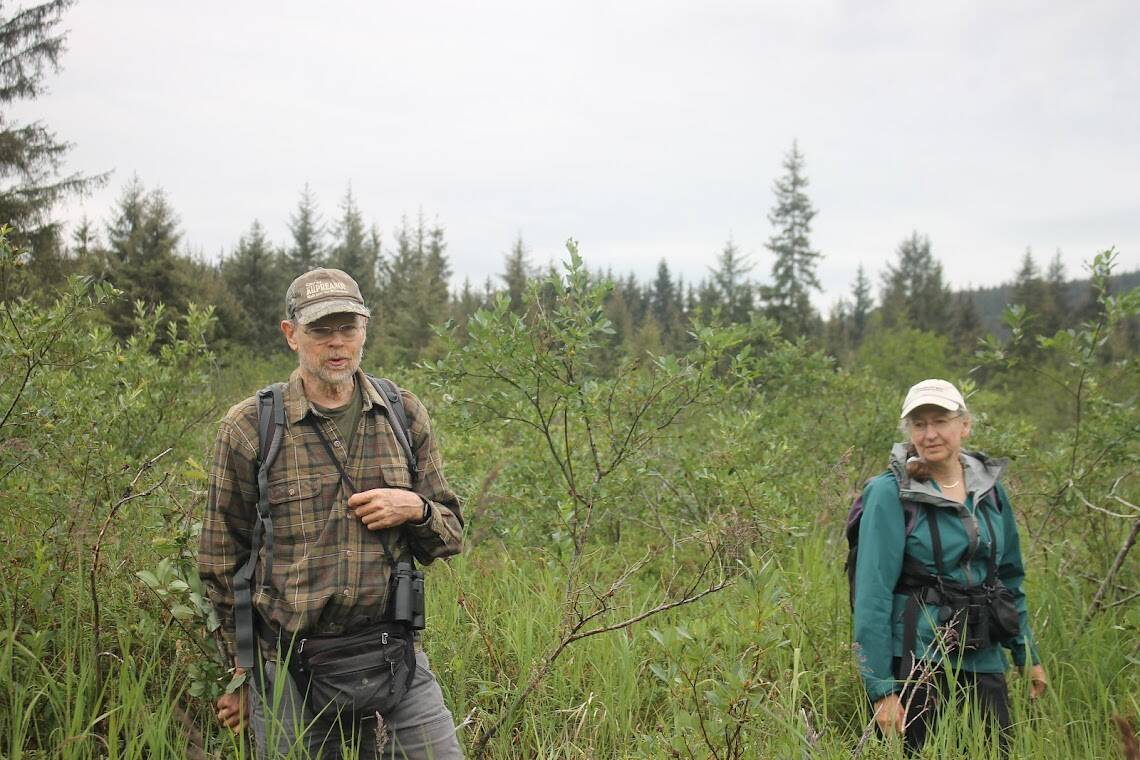Hikers, naturalists and mosquitos alike gathered to wander the blueberry-filled and knee-high bushes while learning about some of Juneau’s wetland meadows.
Two Discovery Southeast naturalists, Richard Carstensen and Steve Merli led a group of around 30 adults of all ages — decked out in raincoats, Xtratuf boots and trekking poles — through a few hours of hiking in the high brush and marshy terrain of the Montana Creek conservation property to learn more about the land and elements of its makeup on Saturday morning.
The hike was a collaboration between the Southeast Alaska Land Trust and Discovery Southeast, a nonprofit organization that has worked to introduce children and families to the outdoors for more than 30 years.
The hike, which started at the Kaxdigoowu Héen Dei trailhead at the end of River Road, meandered through the Montana Creek conservation property, a recreation area created by the Mendenhall Glacier and now serves as an important floodplain in Juneau. The naturalists led the group through the bush and moss following no particular path as a way to preserve the land and not create any definitive paths while walking through the seemingly untouched wilderness.
Carstensen, a founder of Discovery Southeast and who spent his 12 years studying Eagle River, mainly led the discussions and directions. He stopped every so often to point out different aspects of the wetlands that are special to the area. Though Carstensen and Merli were the main leaders of the group, other naturalists also attended and shared their knowledge as well.
The land, scattered with blueberry bushes, bog tea and browning spruce trees was not in its typical state said Carstensen, noting the “remarkably dry” dry spell in June may have made the area less wet than usual.
Ceann Murphy said that even though she was born and raised all her life in Juneau, she hadn’t gotten the chance to go to the wetlands in the Montana Creek conservation property. So, when she saw the posting, she and her friend wanted to check it out.
“I’m having a great time,” she said. “Living here my whole life I can’t believe I never checked this out.”
The naturalists didn’t have anything particularly planned to talk about on the hike, but rather let the wandering adults ask questions as each made their routes through the bushy land — some routes better than others. In the process, there was a tasteful amount of falls that occurred, but none serious. The wetland’s knee-high moss and brush below made for a swift recovery.
Merli, a Discovery Southeast naturalist and the head naturalist at Glacier Valley Elementary School’s nature studies program, said it was a great experience to bring people together and see nature without following a path.
“It’s awesome to get people out on the ground,” he said. The naturalist emphasized the specialness of walking through nature without a path and said it gives another subtle element of information about the nature around the area. “There aren’t many words to describe this.”
• Contact reporter Clarise Larson at clarise.larson@juneauempire.com or (651)-528-1807. Follow her on Twitter at @clariselarson.

